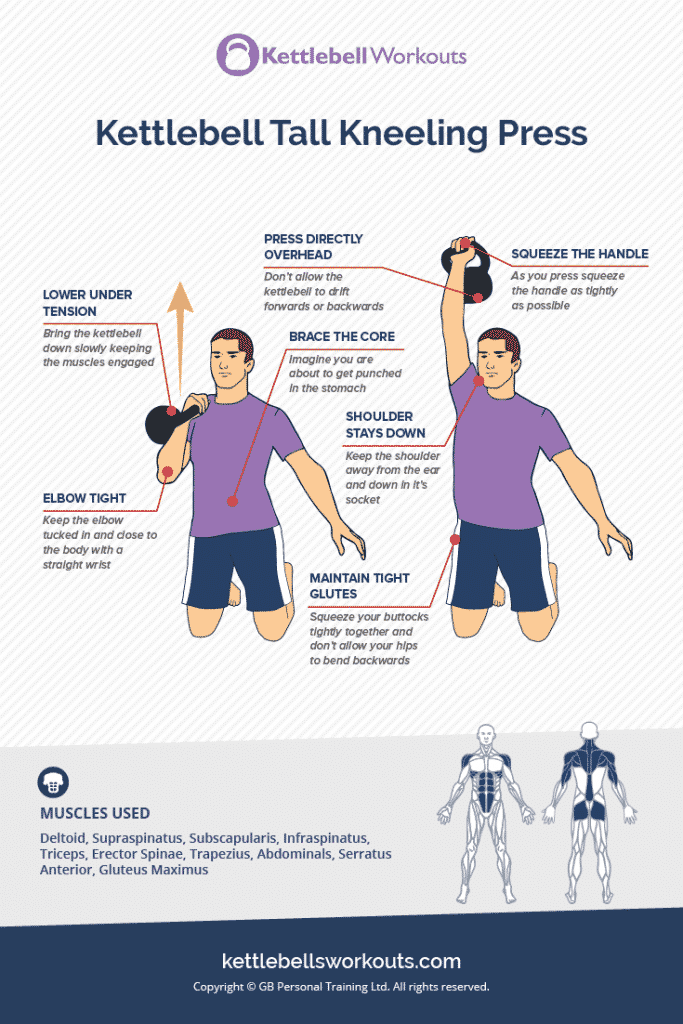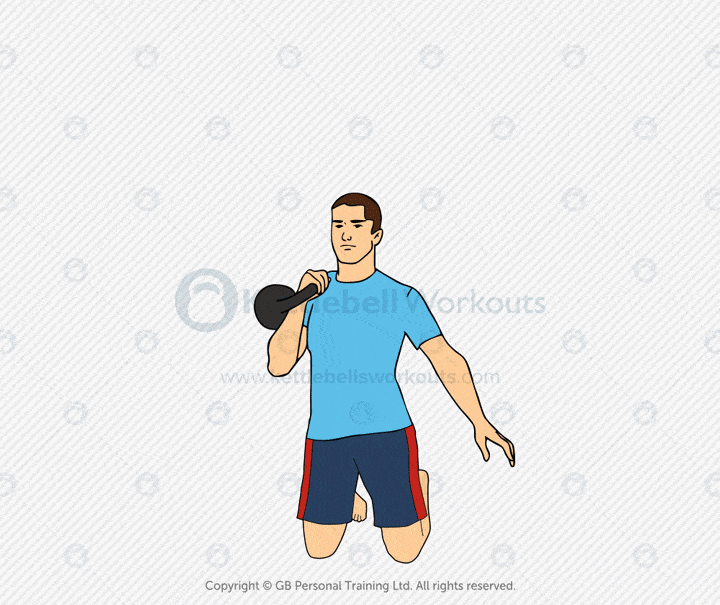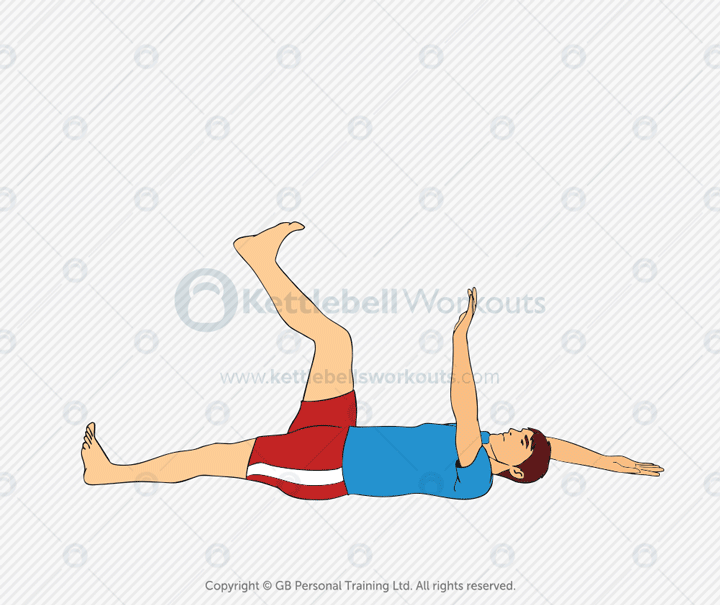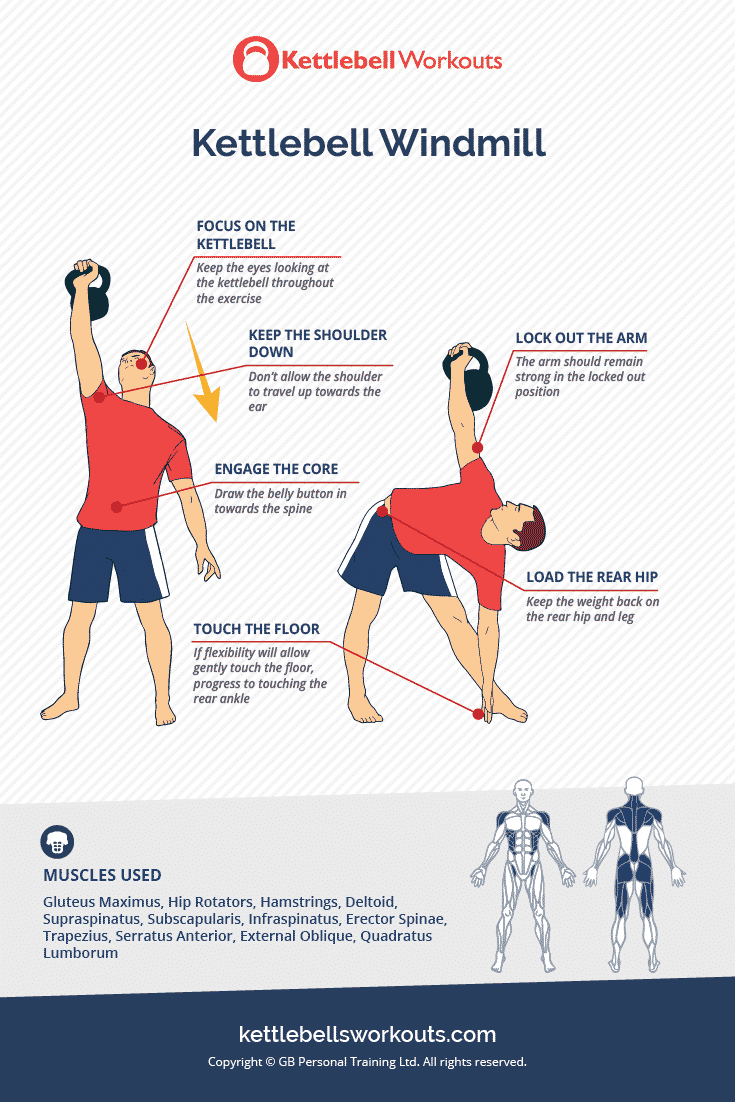Last Updated on 29 July 2025 by Greg Brookes

The kettlebell tall kneeling press looks simple, but it’s a powerful tool for building shoulder strength, postural alignment, and core stability.
By taking your legs out of the equation, it forces you to engage the hips, glutes and abdominals to stabilise the body and press efficiently.
Let’s break it down and show you how to make this overlooked movement a staple in your training.
What Is the Kettlebell Tall Kneeling Press?
It’s an overhead press performed from a tall kneeling position, both knees down, hips extended, glutes engaged, and toes tucked or flat.
From this base, you press the kettlebell overhead using strict form and total-body tension.
Because there’s no help from the legs, it forces the core and shoulders to do all the work.

Why It Matters
The tall kneeling press teaches full-body awareness and eliminates momentum.
It’s excellent for:
- Teaching strict overhead mechanics
- Improving posture and glute engagement
- Enhancing scapular control and shoulder stability
- Building symmetry and core activation
It’s also a great diagnostic tool, if one side feels unstable or weaker, you’ll notice it immediately.
Muscles Worked
- Deltoids
- Triceps
- Core stabilisers
- Glutes
- Obliques
- Upper back
How to Do the Kettlebell Tall Kneeling Press (Step-by-Step)
- Set up on a mat in a tall kneeling position, knees hip-width apart.
- Clean the kettlebell into a rack position.
- Engage your glutes, squeeze your abs, and stay tall through the crown of your head.
- Press the kettlebell straight up overhead, finishing with the bicep by your ear.
- Lower under control back to the rack.
- Repeat all reps on one side, then switch.
Tip: Don’t arch your back to finish the press. Lock your rib cage down and keep the glutes on.
Watch the kettlebell tall kneeling press in action:
Common Mistakes to Avoid
- Overarching the back to complete the press
- Letting the glutes relax, losing the tall kneeling posture
- Pressing forward instead of straight up
- Not locking out the elbow at the top
Warm-Up Drills to Prep for the Movement
- Glute Bridge Hold (30 seconds)
- Half-Kneeling Halo (5 each direction)
- Dead Bug (10 reps)
- Wall Overhead Press with PVC or band (10 reps)

Programming Tips and Reps
- 5–8 reps per side
- Perform 2–4 sets
- Great as part of upper body, postural, or rehab-style training
Use early in your workout to teach alignment and shoulder mechanics, or pair with pulling work for balance.
When to Use This Exercise
- Warm-up or activation drills before pressing sessions
- Rehab or posture-focused routines
- As a strict strength builder for the shoulders and core
It’s simple but very revealing, if you’re cheating a strict press elsewhere, this will expose it.
Coach’s Insight: Greg’s Take
I use this a lot with beginners and advanced lifters alike. It builds discipline and control.
There’s no place to hide, if you’re weak through the glutes or core, you’ll feel it right away.
I often pair it with tall kneeling windmills or single-leg glute work for full-body posture sessions.
Kettlebell Tall Kneeling Press vs Half Kneeling Press
The half kneeling press introduces asymmetry and balance.
The tall kneeling press is more symmetrical and strips the movement down to its essentials, glutes tight, core on, shoulders in control.
Both are valuable, but tall kneeling is a great place to start or refine technique.

Who Should Do This Exercise?
- Beginners learning the overhead press
- Athletes improving postural strength
- Clients rehabbing shoulders or improving motor control
- Lifters who want to refine pressing mechanics
Related Exercises You Can Try Next
- Kettlebell Half Kneeling Press
- Kettlebell Overhead Hold
- Kettlebell Windmill
Want More Smart Kettlebell Training?
Dial in your technique and develop strength that transfers into every movement.
Improve core and shoulder stability further with more kettlebell pressing exercises.
Frequently Asked Questions
Can I do this with two kettlebells? Yes, but only once you’ve mastered the single-arm version. Double bells require more core strength and control.
Is this safe for people with shoulder issues? Generally, pressing anything overhead can aggravate shoulder issues, so if in recovery, start very light and do not work until failure.
What’s the difference between this and a military press? The tall kneeling press removes lower body help and isolates the core and shoulders more intensely.
Should I keep my toes tucked under or flat? Either works, tucked toes help some people maintain more stability. Experiment and see what feels best.




Comments